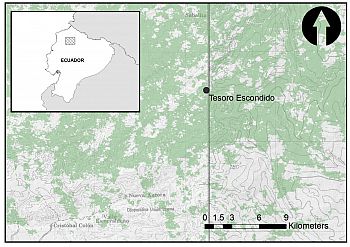In 2005 biologists estimated that there were only 250 brown-headed spider monkeys left in the wild. Our surveys through the Chocoan rainforests of NW Ecuador identified one of the last healthy populations of 150 primates in a 30km2 area of unprotected forest at Tesoro Escondido (Esmeraldas Province)
 'Tesoro Escondido', focus of the project location in Esmeraldas Province, NW Ecuador. Light green shaded areas show remaining forest habitat that require urgent conservation action.
'Tesoro Escondido', focus of the project location in Esmeraldas Province, NW Ecuador. Light green shaded areas show remaining forest habitat that require urgent conservation action.
These forests are currently owned by some 40 farmers, some of whom are keen to conserve the species and forest but face economic pressures to log them. This major fundraising campaign and project supported by Sussex University (UK), the Universidad San Francisco de Quito, the Cambugan Foundation, Tropical Herping and the Washu Project aims to purchase key areas of forest to expand the Itapoa Reserve to ensure long-term protection of the forest habitat for the brown-headed spider monkey.
In parallel, we are working with surrounding farmers to link quality chocolate production to spider monkey conservation by developing 'Spider Monkey Chocolate'. A strategic analysis, conducted in collaboration with environmental law firm Client Earth, identified high-quality cacao (chocolate) production as a potential sustainable income stream that could provide a win-win solution by generating sustainable livelihoods and conserving forest.
Funds and experts have been made available to train the community and improve the quality of cacao processing, with a view to obtaining a better market price through ethical buyers. In return, each landowner must agree to conserve remaining forest, not hunt primates and help with reforestation.
We have also been training community-level parabiologists who continue to monitor primates and forest habitat and, along with local farmers, are essential in developing this project. Parabiologists are locally recruited staff specially trained to carry out a range of conservation-based technical tasks and act as conservation ambassadors within their own forest communities. Our project and the effective role of research in conservation has recently beeen reviewed by Bill Laurence (download the paper here).
Conserving remaining wild populations is vital but the project also includes work with a high-end ecotourist reserve (Mashpi) to reintroduce captive spider monkeys to a protected area - we are 'rewilding' these global priority forests with a primate that plays a key role in maintaining diversity by dispersing seeds of threatened hardwood tree species.
In 2014 - 2015 we will:
- Raise funds for a local conservation organisation to purchase forest from those families keen to sell their lands, and establish a 405 hectare protected reserve for the brown-headed spider monkey to ensure its permanent protection.
- Establish 'Spider Monkey Chocolate' by Improving the quality of the existing cacao (chocolate) plantations within the area allowing local communities to sell directly to premium chocolate companies. In exchange for getting a better price for their product farmers must agree to protect the spider monkey, conserve exisiting forest on their lands and to reforest if their lands have little forest. As a result cacao grown in Tesoro Escondido will contribute to the conservation of one of the most threatened ecosystems in the world.
-
Extend the 'Parabiologist Program' employing local community members to support the Cacao project and continue monitoring the feeding ecology behaviour and population of spider monkeys at Tesoro Escondido. They will also begin to monitor other endangered species in the area.
-
Complete the feasibility study for reintroduction of captive brown-headed-spider monkey populations to the Mashpi reserve to create another core wild population.
-
Begin to reforest degraded areas to connect and extend the core protected area for this species.
See the latest developments in the 'News' section and donate to join us to save one of the top 25 most endangered primates from extinction. We can do it.
